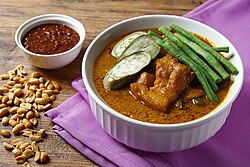Top Qs
Timeline
Chat
Perspective
Kare-kare
Filipino stew dish From Wikipedia, the free encyclopedia
Remove ads
Kare-kare is a Filipino dish featuring a thick savory peanut sauce. It is generally made from a base of stewed oxtail, beef tripe, pork hocks, calves' feet, pig's feet or trotters, various cuts of pork, beef stew meat, and occasionally offal. Vegetables, such as eggplant, Chinese cabbage, or other greens, daikon, green beans, okra, and asparagus beans, are added. The stew is flavored with ground roasted peanuts or peanut butter, onions, and garlic. It is colored with annatto and can be thickened with toasted or plain ground rice.[1][2] Variations of kare-kare can be made with seafood, such as prawns, squid, and mussels, or exclusively from vegetables.
Condiments and other flavorings are usually added. It is often eaten with bagoong (shrimp paste), sometimes spiced with chili, ginisáng bagoóng (spiced and sautéed shrimp paste), and sprinkled with calamansi juice. Other seasonings are added at the table. Variants may include goat meat or (rarely) chicken.
Traditionally, most Filipino fiestas have kare-kare.[3] It is a complex dish to prepare, with a rich umami.
A more modern twist on the classic Filipino kare-kare uses a different dish as the main meat for this dish. Pork is one of the most economical and easiest meats to cook. The most common meats repurposed for kare-kare are lechon (which is also used for lechon kawali)[4] and crispy pata (crispy pork shank). Alternative main proteins are tofu, beef chuck, beef shank, maskara ng baka, or cartilage from the cow's face, and tripe.[5]
Remove ads
History
Summarize
Perspective
Kare-kare's history as a Filipino food goes back centuries. There are four stories as to the origins of kare-kare. The first one is that it came from Pampanga (the province which became known all over the country as the "culinary capital of the Philippines").[6] The Kapampangan people often have a reputation for cooking to their hearts’ content and coming up with deliciously rich fare. The second is that the dish, specifically the sauce, from the galleon ships of Acapulco. Its key ingredient, the mani or peanut, was widely transported in it just like corn, also from the Aztec Empire and from a distant land. Mexico's Costa Pacifica provinces of Jalisco and Guerrero continue to serve Lomo Encacahuatado, practically the same dish. The only difference is the type of pork part. In Mexico it is the loin/ Lomo or Maciza. In the Philippines, it is the pork tail or oxtail. The word "Kare-Kare" is supposedly a diminutive of "Cari" which was a term to denote "golden brown"--- in fact it was what the Spaniards and Portuguese called the brown natives they saw at their ports of call. The third comes from the regal dishes of the Moro elite who settled in Manila before the Spanish arrival (in Sulu and Tawi-Tawi, kare-kare remains a popular dish).[7] The fourth story is from Indian sepoys from Southern India that settled in Philippines during the British occupation of Manila after they rebelled against their British masters. Homesick, they improvised their own cuisine with available materials. They called it kari-kaari, curry, and now, kare-kare. Its name derived from a reduplication of Tamil: கறி, romanized: kaṟi, lit. 'curry; thick sauce'. Kare-kare has a similar flavor to satay because of the peanuts in the sauce.[8]
Remove ads
Preparation

The oxtail (with the skin on) is cut into 2-inch lengths. The ox tripe is boiled until tender. Sometimes pieces of ox feet or shins are added. When the meat is tender, the soup becomes gelatinous. Ground roasted peanuts (or peanut butter) and ground roasted glutinous rice are added to make the soup thicker. Annatto is added to give color. The vegetables used for kare-kare include young banana flower bud or "heart" (puso ng saging), eggplant, string beans, and Chinese cabbage (pechay).[9]
Kare-kare is often served hot with special bagoong alamang (sauteed salted shrimp paste).[citation needed] Vegan and Vegetarian versions emphasize the use of peanuts and coconuts to create the umami.
Remove ads
See also
References
External links
Wikiwand - on
Seamless Wikipedia browsing. On steroids.
Remove ads

